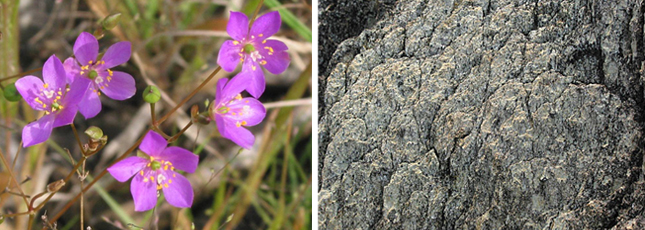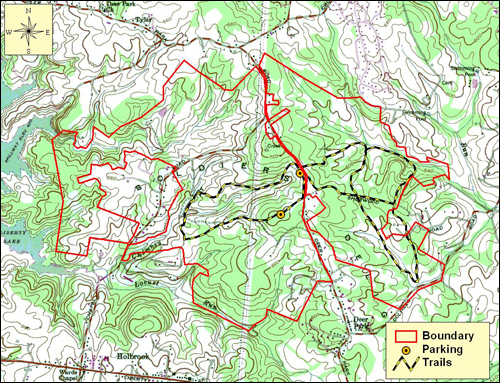Soldiers Delight, Baltimore County
 Want to walk on the bottom of the ocean through a sea of prairie-like grassland and oak savanna in western Baltimore County? Go to Soldiers Delight – the largest remaining serpentine ecosystem in the eastern United States. Serpentine ecosystems are underlain by serpentinite, an oceanic rock which produces shallow soils, susceptible to erosion, with very high levels of magnesium and very low levels of essential nutrients. Despite these harsh growing conditions, many plant and animal species can be seen in the oak savannas and seemingly barren grasslands of Soldiers Delight. These species include colorful asters, prairie grasses, dragonflies, and butterflies. A network of trails crosses through the Natural Area, allowing visitors to see mixtures of these prairie grasses and wildflowers utilized by grassland birds. Due to the unusual abundance of rare and endangered species, it is important for visitors and their pets to stay on the trails.
Want to walk on the bottom of the ocean through a sea of prairie-like grassland and oak savanna in western Baltimore County? Go to Soldiers Delight – the largest remaining serpentine ecosystem in the eastern United States. Serpentine ecosystems are underlain by serpentinite, an oceanic rock which produces shallow soils, susceptible to erosion, with very high levels of magnesium and very low levels of essential nutrients. Despite these harsh growing conditions, many plant and animal species can be seen in the oak savannas and seemingly barren grasslands of Soldiers Delight. These species include colorful asters, prairie grasses, dragonflies, and butterflies. A network of trails crosses through the Natural Area, allowing visitors to see mixtures of these prairie grasses and wildflowers utilized by grassland birds. Due to the unusual abundance of rare and endangered species, it is important for visitors and their pets to stay on the trails.
At European settlement, over 100,000 acres in Maryland were covered with the serpentine savanna ecosystem. William Bose Marye, one of our renowned historians, learned that the settlers referred to the serpentine areas as the "Great Maryland Barrens" because they were large and "bare" of harvestable timber. Tree species were present, but they were often "gnarled and stunted oaks which dotted the landscape." Today, this ecosystem in Maryland has been reduced to about 2,000 acres, almost all of which occurs in Soldiers Delight Natural Environment Area, managed by the Maryland Department of Natural Resources.

Unusual Soils and Plants
To many plants, serpentine soils are highly toxic because of too much magnesium and not enough calcium. Rich soils have one part magnesium for every part of calcium; however, our serpentine soils have a ratio of about 4:1. Plants which take up too much magnesium without the right amount of calcium tend to grow poorly and often die. However, plants at Soldiers Delight are especially adapted to deal with this excess magnesium.

A Community Effort
The endangered ecosystem at Soldiers Delight wasn't always treasured by everyone. At one time, many parts of the area served as dumping grounds for household waste, and scars from motorcycle and horseback riding can still be seen over much of the terrain. A small group of friends formed a grassroots committee in 1959 to forever protect Soldiers Delight. "It all started with 'here's this great natural area, it's very unusual, and it ought to be saved…' " said Jean Worthley who, with husband Elmer and friends William and Frances Fastie, led the way. The creation of Soldiers Delight Conservation Inc. (SDCI) in 1965 allowed Florence Rogers, James Poultney, Mary Lewis and others to boost the effort. Starting with $1 donations from shoppers at local supermarkets, land acquisition began in 1970 thanks in large part to Delegate Richard Rynd of Baltimore County. Now, more than half of a century later, almost 2,000 acres are under the stewardship of the Maryland Department of Natural Resources with continued guidance from SDCI.
Click here for a Print Version of this map.

Special Note: Soldiers Delight Natural Area is used seasonally by hunters.
Directions
From Baltimore: Travel I-695 (Baltimore Beltway) to Exit 19 and take I-795 west toward Owings Mills. Proceed 7 miles and take Exit 7B to Franklin Boulevard. Bear right just before the second stoplight to get on Church Road. In 0.7 mile, Church Road ends at a "T" junction. Turn left onto Berryman's Lane then make a hard left in 0.3 mile onto Deer Park Road. After 0.7 mile, the entrance to the visitor center will be on the right.


Driving directions and aerial views open with Google Maps. For the aerial view button, if an aerial view does not open by default, click on the Satellite icon in the upper right corner and Google Maps will switch to an aerial view of the Natural Area.

Acknowledgments
Scenic View of Soldiers Delight. Photo by: W. Tyndall
Wildlife Collage One: (left to right)
A cobweb skipper busily feeds on the nectar of serpentine chickweed. Photo by: Bill Sherman
Serpentine chickweed is a showy spring wildflower that is only found on serpentine soil. Photo by: W. Tyndall
One of the "gnarled and stunted oaks" looms above the serpentine savanna. In winter, when the trees lack their foliage, visitors can get�a full appreciation of these features. Photo by: W. Tyndall
Wildlife Collage Two: (left to right)
The beautiful fameflower (Talinum tereti-folium) is one of many rare plants well adapted to the harsh growing conditions of serpentine soil. Photo by: W. Tyndall
The color and texture of serpentinite rock resemble that of snakeskin, thus giving this rock type its name. Photo by: W. Tyndall